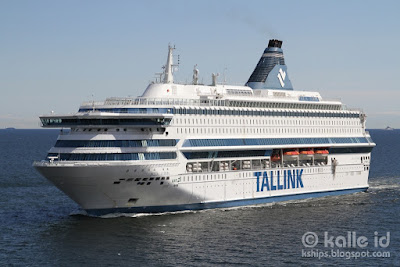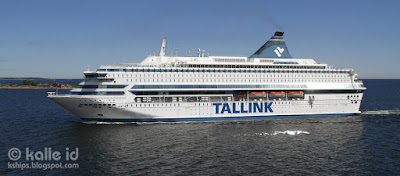I realised recently that I haven't posted any exterior photos of the
Silja Europa since her late-2016 return to the Helsinki-Tallinn 22-hour cruise circuit, and that there is no up-to-date history of her in this blog. So today, we will look at some photos of the SE from last summer.
Silja Europa
IMO 8919805
Name history:
Europa, Silja Europa
Built 1993, Meyer Werft, Germany
Tonnage 59 912 GT
Length 201,78 m
Width 32,60 m
Draught 6,80 m
Ice class 1 A Super
3 013 passengers
3 696 berths
(as of 2013, may have changed)
340 cars
932 lane metres
4 MAN diesels, combined 31 800 kW
2 propellers
2 bow thrusters
1 stern thruster
Speed 22 knots
The
Silja Europa was originally ordered by Rederi AB Slite, one of the owners of Viking Line, in 1989. The
Europa,
as she was to be known (in keeping with Slite's tradition of taking
their names from Greek and Roman mythologies), was to be the jewel in the
company's crown, outdoing both SF Line's (the other Viking Line
partner)
Cinderella and Silja Line's still-under-construction
Silja Serenade and
Silja Symphony. In terms of basic design the
Europa is an enlarged version of the
Athena and
Kalypso, built in 1989 and 1990 respectively (they in turn were based on the
Mariella of 1985 and her sister
Olympia of 1986).
While the
Europa was under construction at Meyer Werft, a disaster
struck the Finnish shipbuilder Wärtsilä Marine, who were building both Slite's
Kalypso and Silja's
Serenade and
Symphony.
Wärtsilä Marine went bankrupt and in the ensuing
reorganisation the prices of the still under construction newbuildings
rose radically, leaving both Slite and Silja Line in heavy debt.
Fast forward to January 1993. During the month the Swedish krona (SEK) was
devaluated by 25%, leaving Slite 200 million SEK short of the price of
the
Europa just two months before the ship was to be delivered.
The situation was further compicated by the fact that the main funder of
Slite, Nordbanken, was also the main funder of Silja Line. While Slite
was better off financially of the two, the bank stood to lose more if
Silja folded (as it perhaps seemed likely to do at the time). Regardless
of what the actual reasons were, Nordbanken refused to grant Slite an
additional loan to secure the
Europa. During the same month Silja Line
signed an agreement with the shipyard to charter the
Europa on
completion of the ship. Slite's assests, meanwhil,e were evaluated by
Nordbanken as being much less valuable than they were. The result
was that Slite was forced to declare bankruptcy and their remaining
assets (
Olympia, Athena, Kalypso and a pair of small achipelago cruise ships operating in Stockholm) were sold, the big ferries for trading
outside the Baltic. The money from selling the ships easily covered the
debts of RAB Slite, in essence meaning the bankruptcy was unwarranted. With large parts of Viking Line's fleet missing,
Silja Line established itself as the dominant shipping company on the
North Baltic and managed to somewhat improve it's financial position.
Returning to the
Europa, she has been christened
Silja Europa
on 5 March 1993 and entered service on Silja Line's Helsinki-Stockholm
route on 14 March 1993. She had been planned for that exact route, and
placing her on the service allowed Silja to cash in on the large-scale
marketing Viking Line had already carried out for the ship. In
1994 the
Silja Europa was the second ship to arrive on the scene of the
Estonia disaster and was appointed head of the rescue operation.
In practice Silja Line found the
Silja Europa to be ill-suited as a running mate to the
Silja Symphony. More importantly the
Silja Serenade – which the
Silja Europa
had replaced on the Helsinki-Stockholm service – was found to be highly
ill-suited for the Turku-Stockholm service, where she had been trasferred to make way for the
Silja Europa on the Helsinki-Stockholm route.
Resultingly, from January 1995 the
Silja Europa moved to the Turku-Stockholm service, with the
Silja Serenade returning to the Helsinki-Stockholm route.
Originally the
Silja Europa had a partially white funnel, with
the seal painted on on blue. However, as there was a tendency for soot to gather in the white part, in 2000 the funnel was repainted all-blue, with the Silja funnel symbol painted on in white (since 1993, both blue-on-white and white-on-blue variants had been used). In 2002, Stena
Line were reportedly interested in chartering the
Silja Europa to replace their
Stena Saga (some claim the staff of the
Stena Saga even visited the
Silja Europa to get to know her). Resultingly Silja Line's then-owner Sea Containers
purchased 42% of the ship from Meyer Werft, which together with the
previously Silja-owned 17% gave them a majority ownership and blocked
the transfer to Stena. In 2004 Sea Containers purchased the remaining
shares of the ship. In 2006, prior to Silja Line being sold to Tallink,
the ownership of the ship was passed entirely to Silja Line.
The
Silja Europa had for a long time suffered from engine
problems, which are particularly problematic on the intensive
Turku-Stockholm route. Compounded with the arrival of Viking Line's new
Viking Grace on the Turku-Stockholm line in January 2013, Tallink swapped the
Silja Europa with the Helsinki-Tallinn 22-hour cruise ship
Baltic Princess in January-February 2013. The
Silja Europa
was transferred under the Estonian flag and marketed as a Tallink ship
(although retaining her Silja-prefixed name). She entered service on the
Helsinki-Tallinn route on 23 January 2013. Initially, she was marketed in Finland as the Europa, in an attempt to maintain a degree of separation between the Tallink and Silja brands, but as all signage, announcements etc onboard continued to refer to the ship under her full name, the practice was quickly dropped.
The ship remained in Tallink service without incident until July 2014,
when her owners took the shipping world by surprise when they made
public the agreement to charter the
Silja Europa to Bridgemans
Services as an accommodation vessel to Australia for 14 months (with a
possible extension to 48 months), starting from August. Thus, the
Silja Europa
sailed to Naantali for conversion to an accommodation ship. At the same
time the ship was repainted with Bridgemans logos on the hull. After
the refit the ship left the Baltic Sea on a lengthy transition to
Barrow Island in northern Australia. She was replaced on the Helsinki-Tallinn 22-hour cruise circuit by the
Baltic Queen.
Most observers (myself included) expected this to be the last that we would see of the
Silja Europa on the Baltic. And we were all wrong. When the charter ran out at the end of 2015, the ship sailed back to Tallinn (although rumour has it potential buyers inspected her in Singapore en-route) and received a partial refit. After covering for docking periods of other ships, she returned to the Helsinki-Tallinn route for the summer season on a somewhat anarchronistic schedule: day cruises, departing from Helsinki in the morning and returning in the evening (some English-language sources mistakenly claim she was used on the 22-hour cruise circuit alongside the
Baltic Queen – a misunderstanding presumably arising from the fact Finnish has two different terms that translate into a English as "day": "päivä", meaning the period from morning to evening, and "vuorokausi", a 24-hour period. Thus, "päiväristeily" and "vuorokauden risteily" both translate as "day cruise", but are completely different products). Unusually, she sailed not from the Tallink terminals in Helsinki's Länsisatama (West Harbour) but from the Silja Line terminal in Eteläsatama (South Harbour).
At the end of August 2016, the
Silja Europa was laid up at Muuga, the freight harbour of Tallinn, for a large-scale refit, with all public rooms (except the ones done the previous spring), cabins, staircases, corridors, etc. rebuilt. Following the refit, the ship re-entered service on the 22-hour cruise circuit between Helsinki and Tallinn in December, replacing the
Baltic Queen. For an overview of the current interiors, feel free to look at
this entry.
And that pretty much brings us to the present: the
Silja Europa remains on the Helsinki-Tallinn 22-hour cruise service, complemented with two-night special cruises to Visby, Riga and Mariehamn during the summer seasons.
The photos below show the
Silja Europa inbound outside Helsinki, photographed from onboard the
Finlandia sailing in the opposite direction. As per normal practice, click on the images to see them in larger size.
 |
| Still looking every inch a Silja Line ship, even with Tallink logos. I've often thought they would be smart to cash in on the ship's perceived special status by just painting her name in large letters on the side in place of the Tallink-text. |
 |
| The Finlandia and Silja Europa pass just on the edge of the Helsinki archipelago, giving impressive views. |
 |
| Always nice when you get sun reflecting from the windows. |
 |
| She is a bit of a chunky lady, to be honest. But I for one like my ladies that way. |
 |
She has a lovely rear, too.
Okay, I'll stop with the questionable puns now. |
Kships will return.











